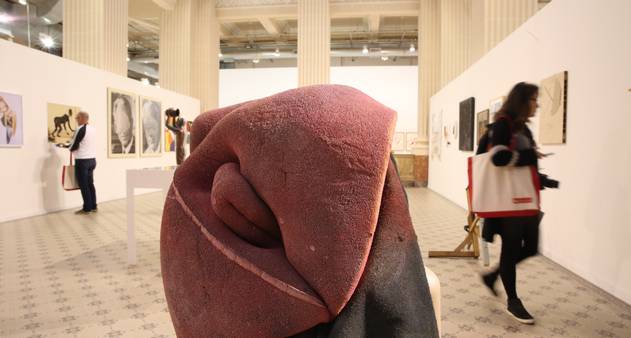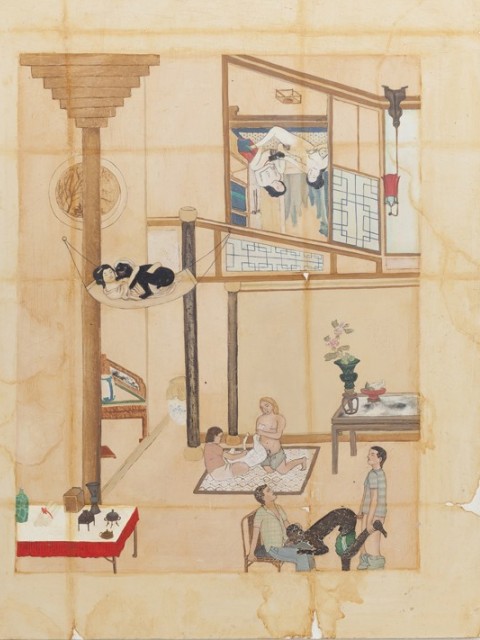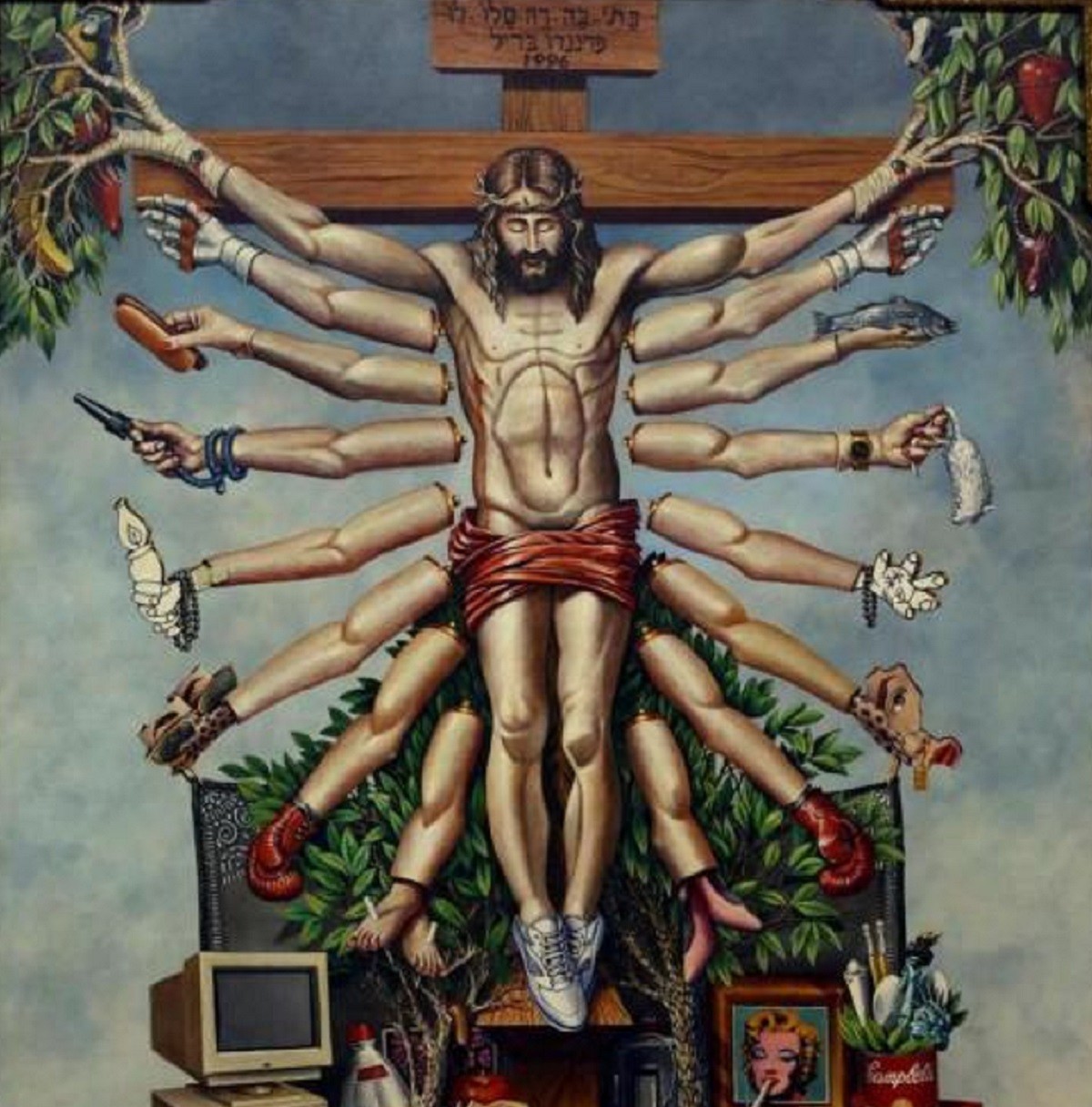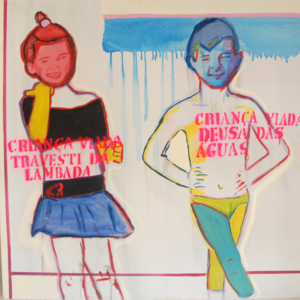Text originally published at Artememoria. Available here.

Curator Gaudêncio Fidelis on Queermuseum, his exhibition that was closed down because of pressure from the far-right.
INTERVIEW SERIES: ON CENSORSHIP

A visual art exhibition became the focal point of political polarization in Brazil last fall. The exhibition, called Queermuseu: Cartografias da diferença na arte brasileira (Queermuseum: Cartographies of Difference in Brazilian Art), opened at Santander Cultural in Porto Alegre in August 2017. In early September, a small group of far-right protesters recorded videos to attack the exhibition targeting the content of certain works, claiming it made apology to pedophilia, bestiality, and the debasing of religious imagery. Suddenly, Santander released a post on their Facebook page that shut down the exhibition a month ahead of schedule.
What followed was a viral online response both for and against the exhibition. Some groups, including conservative politicians and the right-wing organization Movimento Brasil Livre (Free Brazil Movement), or MBL, continued to accuse the exhibition for unseemly content. However, according to a study carried about by the Getulio Vargas Foundation on Tweets related to the exhibition, bots generated nearly 13% of criticism about the exhibition, indicating that the negative reaction to Queermuseum was not nearly as widespread as it originally seemed. Meanwhile, the art community and others denounced the premature closure of the exhibition as censorship. In the months since Queermuseumwas shut down, Gaudêncio Fidelis, the curator of the exhibition, has become an outspoken defender of the freedom of artistic expression. He talks to Artememoria about his exhibition, its closure, and the implications of these events on Brazilian democracy.
Artememoria: Queermuseum came from a long process of critical reflection, one that you developed through the various exhibitions that you have curated over the years. In that context, could you summarize the idea behind this exhibition?
Gaudêncio Fidelis: The idea for this platform came from the perspective of creating a space for dialogue and debate that would be open to questions of expression, identity, gender, and difference. Diversity and difference became generic terms but I used them in a very specific way. Diversity includes the idea of difference, political perspectives on difference, and includes here, but is not limited to, the diversity of form. In the exhibition one may think about a variety of issues that relate specifically to art but, as always, my goal was essentially to create a platform for debate. Even though the exhibition, as a platform for debate, was abruptly shut down, I’ve seen a considerable part of Brazilian society reopening the discussion in a surprising way. It persists and it broadens. In that sense, the exhibition met its original goal.
It’s important to highlight one more aspect of Queermuseum, which sets it apart from other exhibitions. In dealing with questions of diversity and difference, the exhibition starts a conversation very naturally, since those topics relate to a debate already present in Brazilian society. They are also transnational issues, as many countries are advancing the debate on issues of gender expression and identity. I don’t use the term “gender” very much in the exhibition, because in my mind it connotes a binary opposition. I wanted to be more specific than that. Whenever I refered to gender expression and identity, I approached the entire realm of questions involving gender.
The exhibition also involved some specific conceptual questions. The show was conceived as a metaphorical museum, and a provisional one, which allowed the audience to enter and be more than just a contemplative visitor or viewer. I use the word audience very consciously here because the audience is a sort of participant in that setting. Over the years, I’ve begun positioning the artwork slightly lower than usual, creating a horizontal line of sight that’s more approachable for the visitor. It’s a friendly exhibition. I work with these questions related to reception, and how these tools of perception affect the people in the space.
One very visible thing was the safety and comfort of the exhibition entailed. Members of the educational team, who were experiencing the exhibition alongside visitors, also pointed this out. The museum created a sort of safe space where people could interact alongside artwork dealing with these questions of gender and sexuality. The exhibition became a friendly museum that lacks the intimidation of the traditional museum, whose apparatuses usually imposes rituals of interpretation on the work. Moving away from that was definitely a goal of the exhibition.

Artememoria: Did you think there was going to be a controversial reaction to this when you opened the exhibition or did it take time for that reactionary response to grow?
Fidelis: I was always fully aware about what this exhibition meant and the artistic force that it had. But in terms of reception, the most surprising and extraordinary thing was that people loved the exhibition during the twenty-six days it was open. There was a consensus on its artistic merit, and no one considered it moral or defamatory. That consensus grew until the right-wing attacks began and then intensified as they moved onto social media. Extremists approached people in the museum and made aggressive verbal attacks.
Artememoria: It must have been very jarring to experience aggression in the context of a friendly space, as you put it.
Fidelis: There were LGBTQ couples walking hand in hand, alongside people who were eighty or ninety years old, from a totally different generation. Straight couples from several generations were there, too, along with teenagers and children. It was a space of coexistence. A safe space, in the broadest sense of the term. That environment suffered attacks and violent disruptions from the Movimento Brasil Livre (MBL). They are known to use tactics of militia. I don’t say that casually. Militia strategies involve intimidation and coercion, and these same strategies were very effective in attacking the exhibition.
Artememoria: Do you remember a specific moment during the week before the exhibition was shut down, or right afterwards, that illustrates this kind of coercion?
Fidelis: I remember many. They would verbally attack people and record videos on their cellphones and cameras. They would confront members of the audience with by putting their cellphones in peoples’ faces and saying, “look, this is someone who is at the exhibition, who likes porn, who is here looking at porn, ” and all sorts of other demeaning comments.
A case that I didn’t personally witness, but that the educational team reported to me, took place on Wednesday, September 6th. A group of these individuals approached a group of pre-teens with a camera in their hand, saying, “does your family like pedophilia? Does your family like porn? That’s what you’re looking at here, pedophilia and porn?” They filmed everything, with their cameras in peoples’ faces. And then the teacher who accompanied these students and the educational staff helped to protect the pre-teens and leave the situation.
I also had firsthand experiences. For example, Felipe Diehl, a well-known right-wing extremist, came up to me when I was at the exhibition and asked me a number of very aggressive questions. I did not answer and, as he wasn’t happy, so he started to narrate what was going on and launched extremely vulgar language against me until security removed him from the space. Then he started to bang on the door and filmed himself, alleging that he had been attacked, and posted the video that he had recorded online. Such incidents happened several times during those two and a half days, more and more frequently. Santander should have handled those attacks in a different way. They could have argued that this was over the top, even asserting that it resulted in personal damages on a legal level, since all of this was limited to the space of the exhibition. It was hardly in the media, at that point. Santander would later argue that they closed the exhibition because there was a general outcry against the exhibition on social media, but the truth is that the outcry actually only happened in the days after Santander closed the exhibition.
That’s why it’s important to understand the timeline of events. On Sunday, September 10th, Santander closed the exhibition. On Mondays, Santander is always closed, and on Tuesday, a huge protest took place in front of Santander. In only twenty-four hours, several organizations called the protest and over three thousand people attended. As the public reaction continued to grow, the exhibition was extensively covered in the formal press and also gained notoriety, both positive and negative, on social media. There were defamatory videos, but the exhibition also entered the realm of popular media, with critiques of censorship on popular comedy TV shows such as Zorra Total, and messages of supportprojected onto the walls of buildings in several countries.
In other words, it was after the exhibition closed that all of these right wing fanatical, fascist, fundamentalists went online and began to attack Santander because they saw that the institution was weak. The art community that was in favor of Santander right after the attacks initiated turned against the bank after the exhibition was closed. The exhibition closing down also enabled the fundamentalists and the MBL to launch a massive attack against the company. Santander’s strategy was a huge mistake in that sense, since the aggression of just a few people closed the exhibition. There was no popular appeal to shut it down, and doing so had immense consequences for the art community and democracy in general.

Artememoria: The note that Santander released included an abstract statement about art rather than a practical explanation for why the exhibition needed to close. There was one quote in particular that I wanted to hear your thoughts on: “when art is not able to inspire inclusion and positive reflection, it loses its central purpose, which is to elevate the human condition.” What do you think of that?
Fidelis: Santander’s statement is unfortunate and badly written. It has sentences that don’t even make sense, and it’s full of contradictions. They closed an exhibition about diversity, but in the note it says they support diversity. The note morally condemns and apologizes for displaying the artworks. And then the question of inclusion makes no sense, not only in terms of content, but also in terms of strategy. They closed the exhibition and then immediately released the note on Facebook. They didn’t call a press conference to explain the situation, for example. It’s worth remembering that Santander did not contact me, the curator, and made a completely unilateral decision.
Right after the exhibition was shut down, the mayors of Porto Alegre, Rio de Janeiro, and São Paulo immediately announced their support for its closure. As this defamatory process began, there also arose a very serious problem. No one could confirm what was true and what was fake in what people were saying as the false narrative grew. The exhibition was already closed, making it impossible to verify what was accurate and what was slanderous.
Artememoria: In terms of the aftermath of the exhibition, you have done more than 160 interviews and discussions about the Queermuseum. You really fight to discuss what happened. Did that have a personal cost? How much has the closing of this exhibition affected you?
Fidelis: It was very frightening, but also surprising, because I found out that I was prepared to deal with it and reacted very well. The physical and psychological effects were extraordinary. I barely slept for three months, and the situation required superhuman clarity, precision, and equilibrium. I could never rest, because I was always doing an interview or writing an article. At the end of the day, I wasn’t going to make a case for the exhibition in terms of its artistic merit, since I defended the merit of the exhibition from the day it opened. Once the exhibition closed, I used all of my energy to defend principles of democracy, to attack censorship, to show the gravity of what happened. That was my counter-attack to fight the defamatory and false narrative that was constructed about the exhibition. I knew I had to use all my energy to clarify what had happened for the public, to develop my narrative with clarity so that people might understand what was really going on and the implications of the events.
In the accumulation of the many interviews I’ve done and articles I’ve published, I’ve shown that this was an extensive process of censorship. I think people still had a view of censorship in Brazil as limited to something that the government did during the dictatorship, but it no longer is. As we know, censorship continues to happen across the world, and this was a very severe case because of scale. To close down an exhibition that included 263 works of art by 85 artists, many of them well known around the world, in an exhibition that was a very important display of Brazilian art, is something that should not be taken lightly.
Photo: F. Zago/Studio Z. Used with permission from Gaudêncio Fidelis.
More and more, parts of the Brazilian public began to understand the real story, but that required a huge personal effort. I viewed it as a part of my professional responsibility as a curator. I’m almost surprised that I’ve held up physically, but the support of many people helped me throughout those months. It’s almost impossible to lead a normal life when you get thrown into a situation like this. I had to deal with the demands of the press, which I was logistically not prepared for, and there were even changes when it comes to personal security. Because of death threats, I had to take precautions. I was very visible and couldn’t just walk down the street as I had before. People would recognize me easily.
Artememoria: Could you elaborate on the death threats? How did you receive them?
Fidelis: In the protest that happened at Santander, some friends accompanied me to guarantee my personal security. Even though the majority of people at the protest were there in support of the exhibition, the MBL was also there. They would sometimes get close to people and harass them or engage into fights. That happened to me that day, but there were only two or three minor incidents. Eventually they quit, simply because they were outnumbered.
Later, I started to receive a lot of death threats on the Internet. These threats did not come directly from well-known members of the MBL, who are public figures, but from fanatics who act in their name and who followed what happened. They were totally out of control. I had to take precautions so that they couldn’t find out my address. Fortunately, I had recently moved, so few people knew where I lived. Still, that kind of information isn’t hard to find. The danger tapered off as I became more visible, but people close to me, and others who supported the exhibition and defended it publically, would still get threats and were relentlessly harassed on the internet.
Artememoria: Do you think there are other examples of censorship in the arts in Brazil? What are they?
Fidelis: Right after the exhibition closed, a series of incidents happened across the country. For example, fundamentalist politicians denounced a work of art by Alessandra Cunha at the Mato Grosso do Sul Museum of Contemporary Art. On the request of a right wing politician, the police took the artwork down and the artist was accused of pedophilia. But Alessandra Cunha’s piece, called Pedofilia, was actually denouncing sexual crimes against children. The charges were eventually dropped and the work returned to the museum. Also in September, after protests from religious groups, a court order in Jundiaí cancelled a play, The gospel according to Jesus, in which a trans actress represented Jesus. Countless incidents of censorship happened after that and are still happening.
Now we see a growing number of both federal and state Congressmen proposing bills to establish parental ratings for art. There are two laws in Congress, one in the Chamber of Deputies and the other in the Senate, and several in legislative houses around the country. In Chamber of Deputies we have the bill PL 8740/2017, written by Representative Delegado Francischini from the Solidariedade Party (SD), and in the Senate we have the bill 506/2017, written by Senator Magno Malta, a well known fundamentalist from the Partido da Republica (PR). These laws seek to establish age thresholds indicating who can see exhibitions, which is unconstitutional in Brazil because it affects freedom of speech according to the constitution. Also, federal law currently states that there are no age thresholds for visiting art exhibitions. These new laws would affect the content of the exhibitions, which also limits freedom of speech. They state, for example, that you can’t display images with nudity or eroticism, artworks that they say would incite pedophilia, as though it were possible for artwork to do that, or pieces that attack religious symbols. All of this is unconstitutional, but in municipal legislative houses lawmakers have still managed to approve such laws.
Artememoria: What are the main similarities and differences between current censorship and the censorship under the military dictatorship?
Fidelis: In terms of these attacks on freedom of expression in museums and the recent turn to censorship, I think that we need to establish a few differences. During the dictatorship, one knew who the enemy was. Censorship was a state procedure, which is much more objective than the kind of censorship that circulates now. Today, censorship comes from different sources, each with their own interests and agendas, but they converge with a shared goal.
I also think the rule of the law in Brazil is waning. Depending on how Brazilian society reacts, I think it might reach a more serious stage. Right now, things are subtle. People see the signs of what’s taking place, with the criminalization of social movements and the criminalization of art. The latter is more symbolic than concrete, but as that criminalization becomes officially established within law, it becomes real.
Artememoria: It’s interesting that you mention the symbolic criminalization of art. Why are images and symbols important in the current political moment?
Fidelis: Because images can easily enter into the social imaginary. Queermuseum had 263 works of art, and MBL basically chose five to build a disparaging narrative and to justify the censorship of artistic production. There were, for example, representations of naked bodies in the exhibition and not a single one appeared in the narrative they created to attack the exhibition. Only a small subsection of Queermuseum involved sexuality or more explicit images, since the show wasn’t actually about sexuality. But these five images that they chose worked efficiently to build a narrative for the public. Take, for example, the painting of the Christ, Cruzando Jesus Cristo Deusa Schiva. Those who were uninformed and ignorant about art were outraged with it, but in the exhibition it was one of the most celebrated pieces. Surprisingly, people of various religions who visited the exhibition even prayed in front of that work. But combining these specific images, taken out of context, with a negative narrative was very effective. It’s incredible that only five images made that happen.
Artememoria: When and where will the exhibition reopen?
Fidelis: There’s no exact date yet, but we think it will be either at the end of May of the beginning of June in Rio de Janeiro, at the Parque Lage School of Visual Arts. With the reopening, the exhibition will not just return to discuss its artistic merit, but it will also continue carrying the political importance of everything that took place through an extensive series of debates and lectures that will be part of this new presentation
—
Gaudêncio Fidelis is a Brazilian curator. Before curating Queermuseum, he directed the State Institute of Visual Arts in Rio Grande do Sul (IEAVI) and founded the Rio Grande do Sul Museum of Contemporary Art (MAC-RS). He was also director of Rio Grande do Sul Museum of Art (MARGS) and organized a range of exhibitions as curator of the Ciclo de Arte Brasileira Contemporânea in the State Institute of Visual Arts in Rio Grande do Sul. Also a major thinker in the contemporary Brazilian art world, Fidelis received his M.A. from NYU and PhD in art history from SUNY-Binghamton and has published multiple books.
